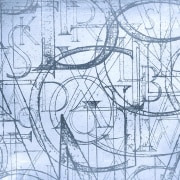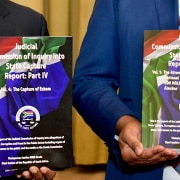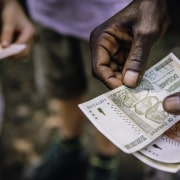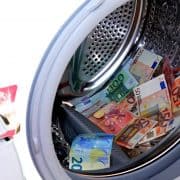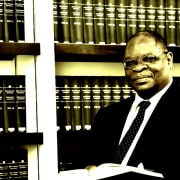|
Getting your Trinity Audio player ready...
|
Money launderers make use of numerous twists and turns in their efforts to hide their trails, but how does the process really happen? Here’s how.
Money laundering is exactly what the words describe – washing the ill-gotten gains of their illegal origins so that what is left cannot easily be traced back to the original source. Deft use of financial detergent can scrub the dirtiest money of criminal traces and ensure it’s seamlessly integrated into mainstream financial systems.
There are numerous reasons for wanting to hide money. Perhaps it’s a huge bribe. Perhaps you don’t want the tax authorities to get wind of it, or your spouse. Perhaps you used other dubious methods to get it.
USA Today recently reported on the case of Paul Manafort, President Donald Trump’s former campaign chairman, who has become one of the first people to be indicted under the special investigation into Russian interference in last year’s US election. Investigators followed the money and were able to file charges of criminal conspiracy and money laundering against Manafort and his associate Richard Gates. The activities in question happened before the two joined the Trump campaign.
In South Africa the so-called Gupta leaks have uncovered a vast network of corruption involving the controversial Gupta family. Allegations that the family laundered almost R500-million through India’s Bank of Baroda over 10 months, are just a few of the unsavoury details that have surfaced.
A new investigation by Dubai’s central bank has just got under way. The bank is probing the use by the Guptas of shell companies to facilitate money laundering. Some 17 500 African companies are registered with the Dubai chamber of commerce, and this begs the question – are all of them legitimate?
How it works
Generally the laundering process comprises three stages:
- Placement (or movement) – the initial entry of illicit money into the financial system.
- Layering (or disguise) – the process of separating the funds from their source, often using anonymous shell companies.
- Integration (or return) – the money is returned to the criminal from a legitimate-looking source.
The first step in the money laundering process is placement, or getting rid of the money.
South Africa’s Prevention and Combating of Corrupt Activities Act (Precca) places an obligation on all people in positions of authority in both the public and private sector to report suspected corruption to the police if it involves more than R100 000. It is therefore necessary to spread the laundered money in portions that will not alert law enforcement agencies and banks or other financial institutions.
This is the stage of the cleaning process, says USA Today, which is most vulnerable to detection. Placement of the money must be done so that it falls outside of the reporting requirements, or is combined with proceeds from legal activities. This may take days or weeks, with unobtrusive amounts of the money being deposited over a period of time. Alternatively, payments on a loan or credit card may be a useful cover.
The indictment against Manafort alleges that he laundered more than $18-million he received for acting as an agent of a pro-Russia political party in Ukraine. He also failed to report the work and income in accordance with federal law. Gates, meanwhile, is said to have transferred more than $3-million from offshore accounts into other accounts he owned.
Another way to dispose of the money quickly is to push it through a cash-intensive business such as a car wash, restaurant, strip club or casino. Once the money is exchanged for, say, casino chips, after a bit of gambling the balance of the chips can be cashed in for fresh money. Some casinos will collude with criminals by exchanging chips obtained externally through an agent, mingling them with the chips of genuine gamblers, and noting the amount down in the balance sheets as paid-out winnings.
Then there is the corporate method, when companies over-invoice or under-invoice for a contract. Over-invoicing usually means there is a kickback for the official who approves the deal, and his bribe is built in to the total amount. The money may be paid to him directly or, if he is smart, to a shell company or offshore account.
By under-invoicing, companies sell their goods or services at a much lower price than they are worth. The grateful recipient of this bargain gives the seller a portion of the embezzled funds for their trouble.
Buying diamonds, valuable stamps, and other priceless but small assets is another way to easily move money across borders.
Blurring the audit trail
Once the money has been distributed, launderers create confusion in the money trail so that investigators cannot easily follow it. This so-called layering is done by transferring the money through a series of transactions, for example by investing in overseas stock markets, or making deposits in various domestic or foreign bank accounts. It’s the most complex stage of the process.
This is where shell companies enter the picture – these are companies that have no physical presence, premises or even staff, and which do no business and therefore generate no revenue. The main purpose of these non-trading companies is to be a front for various financial manoeuvres. Sometimes, though, the company is legitimately set up and kept dormant for future use.
Whether legitimate or not, the disclosure and public registration of beneficial ownership is of prime importance.
In 2009 at the age of 19, Hong Kong resident Luo Juncheng opened a Bank of China account with a deposit of US$500. He then proceeded, over the next eight months, to make nearly 5 000 deposits and over 3 500 withdrawals, ultimately transferring $1.67-billion through the account to offshore locations. He was finally caught and is serving a 10-year prison sentence.
Through machinations such as Luo’s, dirty money may end up in a UK trust managed by a shell company in Panama, which is owned another trust registered in Grand Cayman which holds an account in Luxembourg, which is managed by a banker in Switzerland who has no idea who the real owner is.
In the Guptas’ case, the thousands of leaked e-mails purport to show how the family used Dubai shell companies to facilitate the laundering of hundreds of millions of rands of taxpayers’ money. These allegations have been met with dismay by Dubai officials, who consequently launched the probe.
According to his indictment papers, Paul Manafort was involved with 17 domestic businesses or limited liability companies allegedly owned or controlled by him and Gates, as well as 12 entities in Cyprus, and three others in the UK or the Grenadine islands in the Caribbean.
Living the high life
By the time the integration stage rolls around, the money has become nigh untraceable. However, care is taken to return it to the criminal without drawing unwanted attention, so the money has to appear to come from a legitimate source.
The criminal uses it to buy big luxury items such as real estate, precious metals, jewellery, cars and yachts, art, and securities. Over-invoicing can also be used here to disguise the extra income.
Much of this goes unreported because due diligence is not done by authorities or, for example, estate agents, who seem to not blink an eye at at a cash offer to purchase to the tune of thousands or even hundreds of thousands of dollars. In many cases those offering financial services are mandated to report suspicious transactions, but they turn a blind eye.
Equatorial Guinea’s vice president Teodoro Obiang, who last week was convicted of money laundering, led a lavish lifestyle in France, allegedly with the compliments of his country’s public purse. His seized assets included a 101-room mansion on Paris’s Avenue Foch valued at over €100-million, supercars valued at €5.7-million, and jewellery, art and other luxury goods worth millions more.
If these luxury items are sold soon afterwards, the income looks even more legitimate from the outside.
• Image from Wikipedia

